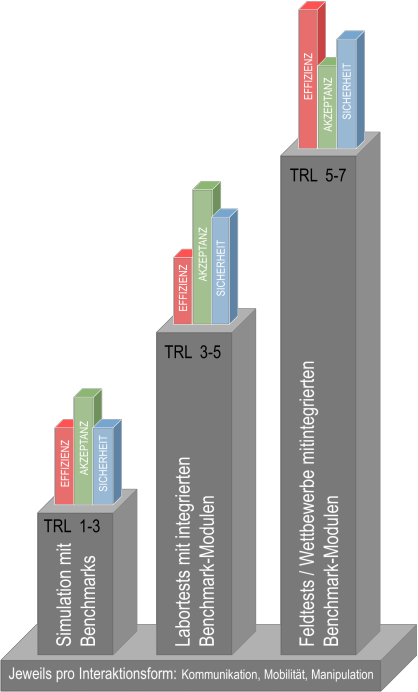The BMBF Project “Robots in Everyday Life”

In the context of the digitalization of society, smart robots, such as the vacuum cleaner robot, are increasingly finding their way into our everyday lives. The project Robots in Everyday Life (RimA) supports and accompanies the RA3 competence centers in the sustainable research and development of intuitive forms of interaction for service and assistance robots. The goal of the transfer center is to create the basis for new, innovative robotics components, services and applications. To this end, robot-independent benchmarks, joint competitions and an overarching knowledge platform will synchronize the work in the competence centers, leverage synergies and sustainably transfer knowledge into everyday life.
Here you can find the current press release: BMBF fördert Transferzentrum „Roboter im Alltag (RimA)“
The Department of Information Systems and the Digital Entrepreneurship Hub (DEH) of Freie Universität Berlin are working on the sub-project “Business Models for Assistive Robotics” which is funded by the German Federal Ministry of Education and Research. The focus of the Gersch working group at the FU Berlin is primarily on economic scenarios for the use of assistive robotics. Furthermore, it also makes important contributions to the development and establishment of a knowledge platform that supports the projects in the competence centers from the beginning in actively shaping the translation with and the transfer of the results into society. Their task and role is to sensitize and qualify the projects in the competence centers from the very beginning, to think about and systematically develop the utilization options and economic viability of possible application scenarios for the use of robots.
For this purpose, established methods from the field of IT entrepreneurship are made available for various application contexts of robotics in everyday life in the form of web app-supported tools, assumptions and benchmarks of typical profitability parameters are analyzed, and their application is taught via tutorials and competitions.
This includes, among other things, the context- and target group-appropriate development of possible value propositions for potential application scenarios (including with an adapted “RimA Value Proposition Canvas”) as well as the development of potential business models based on this (including with an adapted “RimA Business Model Canvas”), including the estimation of important cost and revenue assumptions as the basis of a “RimA Business Planning”. The goal is to enable every robotics project to estimate the economic utilization options of their application development at any time and to communicate them with reference to benchmarks.

Through national assistance robotics competitions as well as an open knowledge platform, an intensive exchange of experiences, open-source software, and also datasets shall take place between the competence centers. RimA aims to further develop the interaction capabilities of robots through benchmarks, competitions and the knowledge platform beyond the competence centers.
knowledge platform beyond the competence centers and to continuously involve new companies or research partners (RimA transfer partners). The annual competitions are to be integrated into the supporting programs of leading international trade fairs such as the Hanover Trade Fair or AUTOMATICA and are to be accompanied by professional public relations work with media impact, such as YouTube reports.
RimA is also intended to serve as a central point of contact for companies, universities and research institutions and, on the basis of feedback, to advise the centers on the further development of existing business models or even the derivation of any new ones that may be necessary. In contrast to the robotic industrial applications, the focus in the competence centers is on people. For this reason, not only economic viability but also safety and acceptance play a central role in the evaluation of robotic capabilities.
The transfer center should also become a mediator between society, science and the robotics industry. For this purpose, it is also necessary to initiate citizen-oriented exchange by means of trade fairs, forums or relevant multipliers of public discourse on the topic of assistance robotics. In the long term, the RimA transfer center is also intended to increase the international competitiveness of start-ups, companies, component suppliers, but also researchers through the annual competitions, sustainable knowledge transfer and strategic software development: innovative, interactive assistance robots “Made in Germany”.
The goal of the RimA transfer center is not to develop new assistance robots, but rather to understand the important mechanisms of action of the basic forms of interaction, to abstract metrics and to support them through various, sustainable exchange formats, but also through concrete assistance and targeted expertise (e.g. safety and economic efficiency) to support the competence centers. From the very beginning, method-supported sensitization for a necessary application and profitability orientation is provided, as well as the iterative development of sustainable business models and business cases by an app-based toolbox.

This post is also available in: German

Eine Einrichtung der
